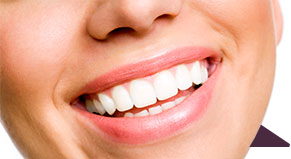Why Does Water Hurt My Teeth? Tooth Sensitivity to Water
February 16th, 2017

Have you ever taken a sip of water and felt a sharp pain in your teeth? This likely means that you have sensitive teeth, and that doing something simple, such as drinking a glass of water, or taking a deep breath through your mouth, can be painful.
So what causes this and how can you fix it?
Tooth Sensitivity
Tooth sensitivity occurs when the protective enamel on our teeth gets thinner, or when our gums recede. There are many reasons why this could be happening:
- You might be brushing your teeth too hard. When you put too much pressure on your teeth while brushing, you can gradually start wearing down the protective layers of your teeth. When this occurs, the tubes or canals that lead to your nerves may become exposed, which can lead to pain or discomfort, especially when eating or drinking something hot or cold. Try using lighter strokes when brushing.
- You could have cavities or loose fillings. Cavities are holes in your teeth that can grow bigger over time. The bigger the hole gets, the more sensitive your teeth can feel. If you think you might have a cavity, or one of your fillings may be loose, make sure to see your dentist right away.
- You’re grinding your teeth. Grinding your teeth can wear down the protective enamel on your teeth, but many people may not even realize that they’re doing it. Oftentimes, people grind their teeth in their sleep.
- You could have a cracked or broken tooth. A cracked or broken tooth can expose the tooth’s nerve, which can cause sensitivity or pain.
- You may have gum disease. Gum disease is caused by plaque, the sticky bacteria that constantly forms on our teeth. If that plaque is not removed with brushing and flossing, it may harden and form “tartar,” which is then very difficult to remove. Teeth sensitivity can be a symptom of gum disease.
- Your mouthwash or toothpaste could be causing it. Some teeth-whitening toothpastes and mouthwashes contain chemicals that your teeth may become sensitive to. Try switching to a mouthwash with less chemicals and a desensitizing toothpaste, such as Sensodyne.
- The foods you’re eating might be too acidic. Excessive consumption of acidic foods or beverages can put your teeth at risk for tooth sensitivity.
Treatments For Sensitive Teeth
If you’re experiencing pain associated with sensitive teeth, there are a number of treatments a dentist can perform that may help, depending on the cause.
- Desensitizing with Gluma is a dental treatment that can help your teeth become less sensitive by stopping by occluding (blocking) the microscopic tubules that compose dentin, thereby preventing the flow of fluid and decreasing sensitivity.
- Gum Disease Treatment Therapy can help treat gum disease, a major contributor of teeth sensitivity, with targeted treatments designed just for you.
- A crown, inlay or bonding can fix a broken tooth or decay that might be causing your teeth to be sensitive. Water Tower Dental Care is proud to offer porcelain crowns in just one visit with CEREC technology.
If you are experiencing tooth sensitivity or have any questions about it, please contact Water Tower Dental Care today.

 There are many ways to brush teeth, but some are much more effective than others. Using a Sonicare Electric Toothbrush, the number one brand recommended by dental professionals, delivers a superior clean for a healthier mouth. For optimal results, even this advanced toothbrush needs to be used properly.
There are many ways to brush teeth, but some are much more effective than others. Using a Sonicare Electric Toothbrush, the number one brand recommended by dental professionals, delivers a superior clean for a healthier mouth. For optimal results, even this advanced toothbrush needs to be used properly. If you’re a fan of DIY dental care, you’ve probably heard of using baking soda to clean and whiten your teeth. Before you take on any DIY healthcare you read about online, it’s important to do your research. Using baking soda too regularly could cause irreversible damage to your enamel. However, that doesn’t mean you should never use baking soda on your teeth. Let’s explore if baking soda is actually good for your teeth now.
If you’re a fan of DIY dental care, you’ve probably heard of using baking soda to clean and whiten your teeth. Before you take on any DIY healthcare you read about online, it’s important to do your research. Using baking soda too regularly could cause irreversible damage to your enamel. However, that doesn’t mean you should never use baking soda on your teeth. Let’s explore if baking soda is actually good for your teeth now. The last thing you want is yellow teeth after years of wearing braces. But unfortunately, it’s a very common occurrence. If you don’t take care of your mouth while you’re wearing braces, you might be surprised to see white squares where your braces were on yellow-stained teeth after your dentist removes them. Thankfully, it’s easy to avoid this experience. Here are some reasons why people get yellow teeth after braces and how to prevent this from happening. We’ll also talk about how you can fix stained teeth after braces.
The last thing you want is yellow teeth after years of wearing braces. But unfortunately, it’s a very common occurrence. If you don’t take care of your mouth while you’re wearing braces, you might be surprised to see white squares where your braces were on yellow-stained teeth after your dentist removes them. Thankfully, it’s easy to avoid this experience. Here are some reasons why people get yellow teeth after braces and how to prevent this from happening. We’ll also talk about how you can fix stained teeth after braces. Many people think they should brush their teeth right after they eat. At first glance, this seems to make sense. If you brush your teeth after a meal, you should keep your teeth healthy by getting rid of the food in your mouth, right?
Many people think they should brush their teeth right after they eat. At first glance, this seems to make sense. If you brush your teeth after a meal, you should keep your teeth healthy by getting rid of the food in your mouth, right? We love to see our patients taking care of their teeth with proper brushing habits. While most people brush twice a day, we do get some asking if they can brush their teeth too much and damage their teeth that way. Many people are surprised to hear our answer: yes, you can actually brush too much. But before you start cutting down your time with your toothbrush, keep reading to find out exactly what brushing too much means.
We love to see our patients taking care of their teeth with proper brushing habits. While most people brush twice a day, we do get some asking if they can brush their teeth too much and damage their teeth that way. Many people are surprised to hear our answer: yes, you can actually brush too much. But before you start cutting down your time with your toothbrush, keep reading to find out exactly what brushing too much means. It may seem elementary to you, but believe it or not, many people still don't brush their teeth correctly. Either they don't do it for long enough time, concentrate on the wrong areas, brush too hard, or just completely misuse the toothbrush. For our Water Tower Dental Care patients, and anyone else that has discovered our blog, we would like to provide you with the steps to properly brushing your teeth.
It may seem elementary to you, but believe it or not, many people still don't brush their teeth correctly. Either they don't do it for long enough time, concentrate on the wrong areas, brush too hard, or just completely misuse the toothbrush. For our Water Tower Dental Care patients, and anyone else that has discovered our blog, we would like to provide you with the steps to properly brushing your teeth. Wet the toothbrush and apply a thin strip of toothpaste. Although there is a plethora of toothbrushes to choose from, we don't recommend a specific design of brush, rather it's more important to find a brush that if manual is soft and if electric, ultrasonic. Richard H. Price, DMD and consumer advisor for the
Wet the toothbrush and apply a thin strip of toothpaste. Although there is a plethora of toothbrushes to choose from, we don't recommend a specific design of brush, rather it's more important to find a brush that if manual is soft and if electric, ultrasonic. Richard H. Price, DMD and consumer advisor for the  When using a manual soft toothbrush, start by brushing the outer surface of your upper teeth, then your lower. Keep the bristles at a 45-degree angle from your teeth and sweep or roll away from the gum line. Your gums are very sensitive and must be treated with care when brushing. Never brush up, into the gums, always away. When using an electric ultrasonic toothbrush, hold bristles at a 45-degree angle at gum line and slowly move brush across teeth.
When using a manual soft toothbrush, start by brushing the outer surface of your upper teeth, then your lower. Keep the bristles at a 45-degree angle from your teeth and sweep or roll away from the gum line. Your gums are very sensitive and must be treated with care when brushing. Never brush up, into the gums, always away. When using an electric ultrasonic toothbrush, hold bristles at a 45-degree angle at gum line and slowly move brush across teeth. After the outer surface, focus on the inner surface of the teeth, first the upper then lower teeth. Again, brush away from the gums at a 45-degree angle.
After the outer surface, focus on the inner surface of the teeth, first the upper then lower teeth. Again, brush away from the gums at a 45-degree angle. Clean the chewing surfaces of the teeth. You can be slightly more aggressive with the surface of the teeth, but nothing too hard. Pay extra attention to the hard-to-reach back teeth and areas around fillings or crowns.
Clean the chewing surfaces of the teeth. You can be slightly more aggressive with the surface of the teeth, but nothing too hard. Pay extra attention to the hard-to-reach back teeth and areas around fillings or crowns. Once you've finished on the teeth, give your tongue a gentle brush to remove any bacteria and to keep your breath fresh longer. We highly recommend using a tongue scraper as well.
Once you've finished on the teeth, give your tongue a gentle brush to remove any bacteria and to keep your breath fresh longer. We highly recommend using a tongue scraper as well.




 Website Powered by Sesame 24-7™
Website Powered by Sesame 24-7™